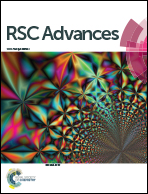A long-wave optical pH sensor based on red upconversion luminescence of NaGdF4 nanotubes†
Abstract
A long-wave optical pH sensor based on intense red upconversion (UC) luminescence of NaGdF4 nanotubes and bromothymol blue was explored. By detecting the UC spectra of NaGdF4 nanotubes in aqueous solution, the sensing system could work on the pH measurement. The intensities of the red emission were linear with pH value changing from 6 to 8.


 Please wait while we load your content...
Please wait while we load your content...